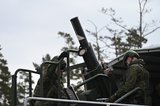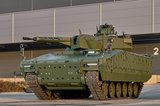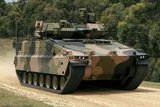The British Army’s Land Mobility Programme – all change but no progress?
The UK’s Land Mobility Programme, an effort to replace thousands of British Army vehicles, may be about to undergo a radical change in direction.
Ceradyne will provide equipment for two components of the US Army’s Soldier Protection System (SPS) under two separate low-rate initial production (LRIP) contracts announced on 1 November.
Under the first, the company will provide next-generation helmet systems for the Integrated Head Protection System (IHPS). This aims to give soldiers a lighter-weight ballistic helmet system that also provides passive hearing protection and increased blunt-impact performance. The helmet system includes accessories such as mandible, visor, night vision goggle attachment device, rails and modular ballistic applique.
The company will deliver more than 5,300 IHPS helmet systems under the $7 million LRIP contract, with production set to start in 2017.
Under the second contract the company will supply Vital Torso Protection (VTP) – Enhanced Small Arms Protective Inserts (ESAPI) lighter-weight body armour inserts. This $36 million LRIP calls for more than 30,000 ESAPI, with production also expected to start in 2017.
The SPS will replace the army’s current personal protective equipment (PPE) system. It is designed to defeat current threats while providing an overall weight reduction for soldiers compared to existing PPE.
Cheryl Ingstad, business manager, Advanced Ceramics Platform – Defense, 3M, said: ‘We are honoured to be the awardee of these prestigious contracts. The SPS programme represents the highest level of lightweight technology to date. Our focus from the onset has been to meet the army’s stringent specifications for the SPS, and that will continue as we move into initial production.
‘As a leading science company, 3M has deep expertise in advanced lightweight materials, which, combined with our proven production history, differentiates our defence offerings.’

The UK’s Land Mobility Programme, an effort to replace thousands of British Army vehicles, may be about to undergo a radical change in direction.

The Land Mobility Programme is the biggest UK opportunity for the next few decades if it all falls into place. Companies have been filling their dance cards as milestones approach in the hope they are not the mirages of the past.

The war in Ukraine has made it clear: the battlefield waits for no one. Military operations now take place in fast-paced environments, and speed is not just about the fight itself – it is about the entire ecosystem of warfare.

Romania’s effort to buy infantry fighting vehicles is expected to include five configurations: a standard platform with a 30mm autocannon, a command variant, an armoured recovery vehicle, a medical evacuation vehicle and a 120mm self-propelled mortar.

Team LionStrike has demonstrated its offering for the British Army’s Land Mobility Programme with plans to bid the Chevrolet Silverado and two variants of the platform: the Infantry Squad Vehicle and General Support Utility Platform.

South Korea’s particular geopolitical situation and threat environment has created a defence industry ecosystem of substantial size and breadth.